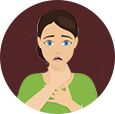What is angina?
Angina, the medical term for chest pain, strikes when your heart’s blood supply decreases due to the narrowing or blockage of one or multiple blood vessels that supply blood to it. But what does angina feel like? Well, if your heart suddenly feels like it’s being squeezed or strangled, it could be angina, which is usually characterized by a feeling of tightness or heaviness in the chest region.
What happens in angina?
 There’s a reason why your heart is one of the most vital organs in your body – a tireless organ that works round-the-clock to keep you alive and kicking. To abide by this relentless work cycle, it needs a regular and continuous supply of oxygen-rich blood and nutrients, the loss of which can have grave consequences.
There’s a reason why your heart is one of the most vital organs in your body – a tireless organ that works round-the-clock to keep you alive and kicking. To abide by this relentless work cycle, it needs a regular and continuous supply of oxygen-rich blood and nutrients, the loss of which can have grave consequences.
Our heart receives its fuel through an intricate pipeline of blood vessels called the coronary arteries. Consider this, what happens when a pipeline gets partially or completely blocked? There is a loss of supply to the end user and an increased strain on the walls of the pipe. The same happens when these coronary arteries get narrowed or blocked (you are suffering from what is called the coronary artery disease) – your heart receives a less than the optimum amount of oxygen-rich blood which ultimately results in a squeezing, throttling or strangulated feeling in your chest region. This chest pain and feeling of discomfort caused due to partial or complete blockage of the coronary arteries, is called angina.
Angina symptoms

Chest pain that travels
Angina is no regular pain i.e. it has its own distinct characteristics. If you are suffering from angina, the pain may begin as a dull ache that spreads across your chest and to the neck, jaws, shoulders, throat, and your back.

Breathlessness
If you have angina, remember that your heart is receiving less blood supply and that your chest region is experiencing tightness. Thus, an angina attack may be accompanied by difficulty in breathing, restlessness, and gasping.

Heaviness
Angina causes a feeling of heaviness in the chest area, especially on the left side where your heart is located.

Squeezing
Have you ever squeezed a stress ball? Not only is your heart under stress as you experience angina, but it’s probably also experiencing exactly what that stress ball is feeling – like its being strangulated or throttled.

Stomach symptoms
Yes, not all angina symptoms are restricted to your heart! Surprised? Gastrointestinal symptoms like acidity or heartburn, indigestion, and nausea may also occur during an angina attack.Chest pain at rest or exertion, most commonly after dinner is called as post-prandial angina. It is a likely marker of severe Coronary artery disease and should be considered an indication for Coronary Angiography.

Sweating
If you are sweating excessively and your palms are all clammy, it may not be a panic attack. These two characteristics are also commonly seen during an angina attack.

Fatigue
If you are usually a very active person and are suffering from an unusual bout of lethargy, then it may be a cause for concern. Such an unusual feeling of tiredness and lethargy may accompany or follow an angina attack.
Common angina triggers
Imagine a juggler who is juggling 5 balls. Then, one by one more balls are thrown in and after a while, it gets beyond his capacity and he becomes tired and breathless. The same thing happens when you are suffering from angina.
In angina, your heart is already under a lot of strain due to a decreased oxygen supply. Any physical exertion or emotional stress, at this point, only increases the burden on your heart, ultimately triggering an angina attack.
Causes of angina
The common factor between all angina causes is the fact that they all ultimately result in partial or complete blockage of vessels that supply blood to the heart. They differ only in the way this blockage is brought about, which includes:
- Narrowing of the blood vessels due to plaque deposit (Atherosclerosis)
- Damage to the arteries from other factors such as smoking, high blood pressure, diabetes, etc. may lead to blood clots that can partially or completely block an artery.
- Spasm in a blood vessel
Atherosclerosis
 Atherosclerosis refers to the narrowing and clogging of coronary arteries with cholesterol and fatty deposits called plaques.
Atherosclerosis refers to the narrowing and clogging of coronary arteries with cholesterol and fatty deposits called plaques.
What causes atherosclerosis (narrowing of blood vessels)?
Our coronary arteries are hollow pipes which have smooth and elastic walls to ensure smooth passage of blood. As the fat deposition begins, other substances traveling in the blood stream such as waste products, calcium, cholesterol, and platelets begin to adhere to this sticky fat leading to the formation of a layer called a plaque.
What makes plaque dangerous?
It narrows our arteries, and hinders the blood supply to the heart which results in angina.
Now while plaque deposition could happen in anyone, some people are more susceptible than most. These include smokers, people with high BP, high cholesterol, and diabetes.
During your annual check-up, your dentist cleans your teeth to remove the plaque build-up on the teeth. However, getting rid of plaque is not so simple when it comes to your arteries. The build-up of plaque can be slowed by having a low-fat, low-sugar, low-sodium diet; exercising regularly; managing BP and sugar levels; and quitting smoking.
 Damage to the arteries
Damage to the arteries
Conditions like high blood sugar and blood pressure can cause damage to our coronary arteries by breaking or rupturing the plaque, as can smoking. If the plaque deposits break or rupture, our body’s defense system tries to repair the injury by forming a blood clot. This blood clot can cut off blood flow and make the heart gasp for oxygen. At times, this blood clot may partially or completely block the blood supply to the heart muscle leading to serious outcomes like a heart attack.
 Spasm
Spasm
A blood vessel may experience a spasm that can make it contract thereby reducing blood supply to the heart.
The coronary arteries may go into spasm due to many things such as exposure to cold weather, heavy exercise, or as a response to certain substances like medicines and recreational drugs.
Whatever the cause, angina may signal a serious heart condition. It is better not to take any chances and consult your physician if you experience any kind of heaviness, tightness, or gripping pain in your chest region.
Know the different types of angina
1. Stable angina (Angina Pectoris)
Stable angina is the most common type of angina. This type of angina strikes only on exertion or emotional trauma. In other words, stable angina is the type of chest discomfort you experience only after vigorous physical activity like climbing a flight of stairs or jogging around a couple of blocks or after some emotional trauma. This is because during these times the heart has to put in extra work to meet the body’s oxygen demand.
In stable angina, even though the coronary artery is clogged, enough blood flows past the plaque and the heart continues to receive adequate blood supply during day-to-day activities. However, when the heart needs to work extra hard, for example when you are walking along a slope, the heart needs more blood to cope up with the added strain of activity. At such times, the plaque build-up prevents extra blood from reaching the heart resulting in chest pain and discomfort. The amount of exertion it takes to bring on the angina attack differs from person to person. The symptoms are temporary lasting 15 minutes in many cases. Stable angina can be relieved by resting and with appropriate medicines as may be prescribed by your doctor; or taking such other steps as may be advised by your doctor.
2. Unstable angina
Unstable angina is dangerous because it is more commonly associated with a heart attack. It is the chest pain that can strike suddenly without any warning and can occur when you are at rest or with little physical exertion. The chest pain that occurs in unstable angina can be extreme and long-lasting and recur many times. It can be a warning signal of a looming heart attack. Unstable angina cannot be relieved by rest or medicines alone.
3. Variant angina
Variant angina is not caused by blockage of the arteries due to plaque build-up, but by a spasm in a coronary artery. It almost always occurs when one is at rest. Variant angina might strike at night while you are sleeping or resting. It is also referred to as Prinzmetal angina. The spasms occur in cycles. Proper treatment can help to relieve the symptoms of this type of angina.
4. Microvascular angina
This type of angina accompanies a severe heart issue called as a coronary microvascular disease (MVD). This is caused by improper functioning of the tiny microvascular blood vessels that feed your heart. This condition is sometimes also called Syndrome X and small vessel disease.
Difference between different kinds of angina

How to relieve an angina attack?
Several medications can improve stable angina symptoms. However, you should consult your doctor in this regard.


